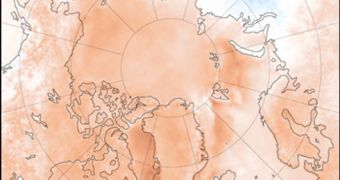Researchers find themselves puzzled by an unexpected phenomenon, namely the accelerating melting process of ice sheets on both the Arctic and the Antarctic. The reason why the melt is unexpected is because it doesn't only happen along specific portions of the two shelves, as it has done until now, but also on vast shorelines, which have been untouched by the effects of global warming before. For example, the entire shoreline of West Antarctica is currently generating icebergs, while in the past only the Peninsula exhibited such behavior.
Geologists warn that this process cannot be reversed from year to year and that, even if actions on climate are taken today, it would take a few decades before the ice sheets regenerate to the levels they reached some 20 or 30 years ago. They say that international effort must be made immediately, if the world is to avoid having the ice sheets melting into the ocean, raising its level and threatening millions. There are currently vast numbers of people living on the shorelines, in cities such as Tokyo and New York.
On Wednesday, a new report released by an international group of climate experts and geologists again refuted the arguments of global warming critics, who pointed out that the Antarctic was actually getting colder. Their study stacks upon others that uphold the same thing – even though a brief period of cooling occurred, the general trend is that of melting, and it's currently accelerating, in a domino effect of sorts.
“It now appears certain that both the Greenland and the Antarctic ice sheets are losing mass and thus raising sea level, and that the rate of ice loss from Greenland is growing. New data also confirm that warming in the Antarctic is much more widespread than it was thought prior to IPY,” a report by the International Polar Year's steering committee details.
“The warming we see in the peninsula also extends all the way down to what is called West Antarctica. That's unusual and unexpected,” Scientific Committee on Antarctic Research Executive Director Colin Summerhayes, who is also a member of the committee, adds.
Some have already begun to talk about the collapse of the West Antarctic Ice Sheet, and their fears are not at all misplaced. There are numerous factors that contribute to the decline of the ice, and global warming is only the trigger. Under it, there are lakes that drive the glaciers towards the ocean, where sea-based ice no longer exists to halt the advance. Because of climate change, crevasses appear in it, and huge chunks of ice have fallen apart from their homes for millions of years. The cracks occur only along the crevasses, which means that they can be used as a warning signal.
Thus far, the sheets in Greenland have been filled with them, as have been huge portions of the West Antarctic. Predictions as to when large amounts of ice will break vary from study to study, but all deadlines range from a few years to a few decades. No matter which one of them is right, the world doesn't have much time to come up with a solution.

 14 DAY TRIAL //
14 DAY TRIAL //